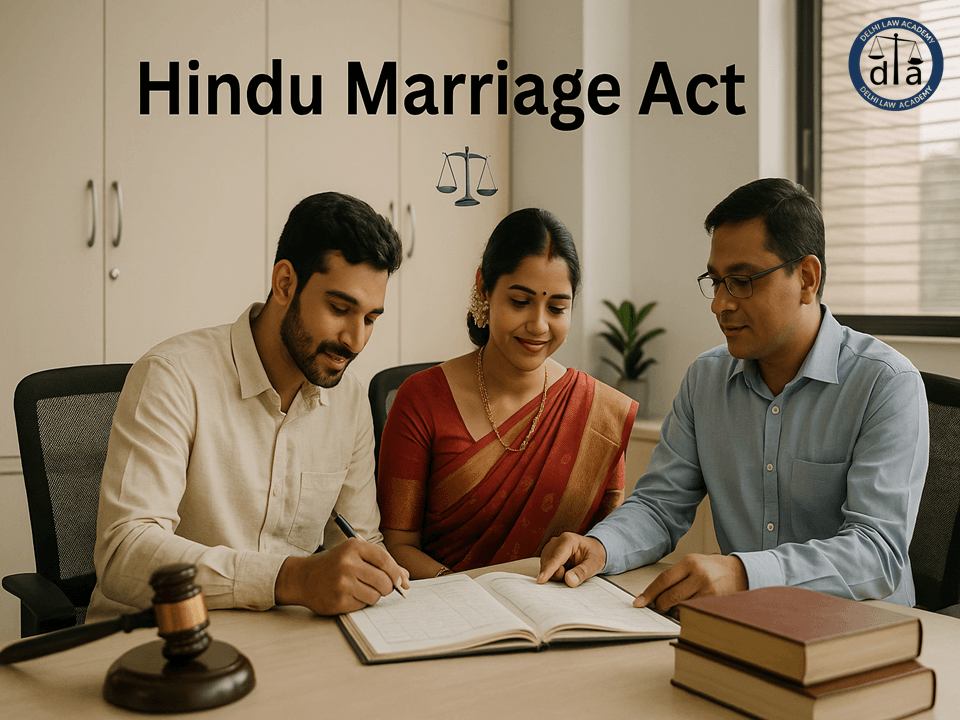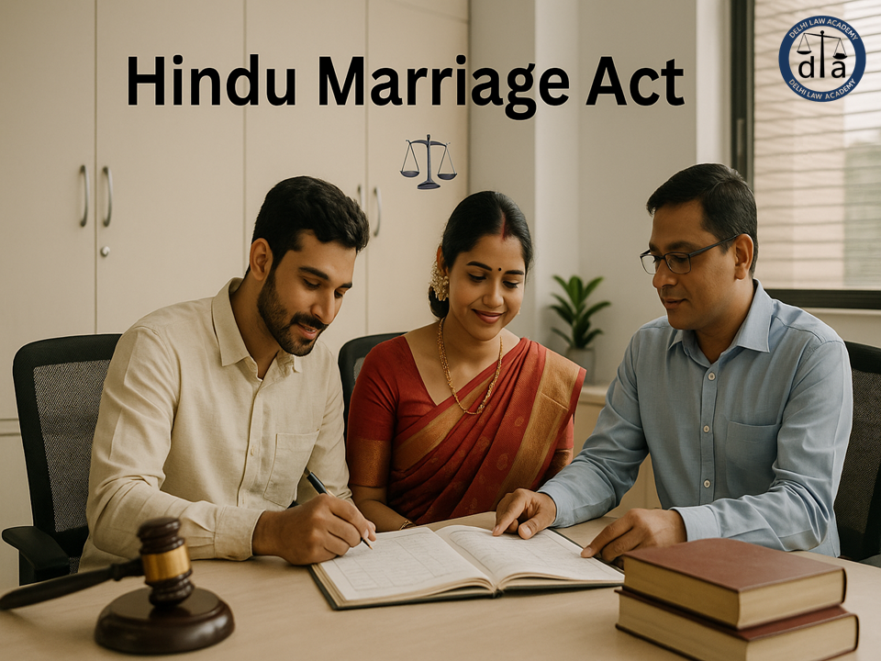
📘 Hindu Marriage Act Explained – Sections 1 to 7
Preparation for RJS, DJS, PCS (J) and Other Judicial Service Exams
The Hindu Marriage Act is an important component of most Judicial Service exams in the country. Its thorough knowledge is a must for all aspirants of RJS, DJS, PCS (J) and other Judicial Service exams. To help such aspirants, DELHI LAW ACADEMY JAIPUR has launched a series of study material modules on all important aspects of this important part of their syllabus:
📚 HINDU MARRIAGE ACT : SECTIONS 1 – 7
📝 Topics Covered:
- Application of Act
- Who is a Hindu by religion?
- What is domicile?
- Non-applicability to STs
- Meaning of ‘Hindu’
- Conditions of Marriage
- What is Saptpadi
- Ceremonies for a Hindu marriage
Supreme Court judgments mentioned in this post:
- Central Bank of India v. Ram Narain [1955]
- Bhaurao Shankar Lokhande v. State of Maharashtra [1965 SC]
🌍 Territorial Extent — Section 1
This Act extends to the whole of India
• except Jammu and Kashmir
⚖️ Applicability
This Act applies also
• to Hindus domiciled in India
• who are outside India
🏠 What is Domicile?
The simplest definition given by Chitty J. in Craignish v. Craignish:
That place is properly the domicile of a person
• in which his habitation is fixed
• without any present intention of removing therefrom
Two constituent elements:
• a residence of a particular kind and
• an intention of a particular kind
There must be the factum and there must be the animus.
It is also a well-established proposition that a person may have no home but he cannot be without a domicile.
In order to make this rule effective, the law assigns what is called a domicile of origin to every person at his birth. This prevails until a new domicile has been acquired — the domicile of choice.
🧑⚖️ Supreme Court in Central Bank of India v. Ram Narain [1955 SC]
The only intention required for proof of a change of domicile is an intention of permanent residence.
What is required to be established is that the person has voluntarily fixed the habitation of himself and his family in the new country, not for a mere special or temporary purpose, but with a present intention of making it his permanent home.
Residence alone, unaccompanied by this state of mind, is insufficient proof.
If a person leaves the country of his origin with an undoubted intention of never returning to it, his domicile of origin adheres to him until he actually settles with the requisite intention in some other country.
📜 Application of Act — Section 2(1)
This Act applies
(a) to any person who is a Hindu by religion, including a Virashaiva, a Lingayat, or a follower of Brahmo, Prarthana or Arya Samaj.
(b) to any person who is a Buddhist, Jain or Sikh by religion.
(c) to any other person domiciled in India who is not a Muslim, Christian, Parsi or Jew by religion, unless it is proved that he would not have been governed by Hindu law in these matters if this Act had not been passed.
🕉️ Who is a Hindu by Religion?
- Any child, legitimate or illegitimate, both of whose parents are Hindus by religion.
- Any child, legitimate or illegitimate, one of whose parents is a Hindu by religion and who is brought up as a member of that parent’s family or community.
- Any person who is a convert or re-convert to Hindu religion.
☸️ Who are Buddhists, Jains or Sikhs by Religion?
Definition is similar to that of ‘Hindu by religion’.
🚫 Non-Applicability to STs — Section 2(2)
This Act shall not apply to members of any Scheduled Tribe unless the Central Government, by notification, otherwise directs.
📖 Meaning of ‘Hindu’ — Section 2(3)
In this Act: Hindu is a person to whom this Act applies, even though he is not a Hindu by religion.
💑 Conditions of Marriage — Section 5
A marriage may be solemnized between any two Hindus if the following conditions are fulfilled:
- Neither party has a spouse living at the time of marriage.
- At the time of marriage, neither party is incapable of giving valid consent due to unsoundness of mind, or suffers from a mental disorder making them unfit for marriage and procreation.
- Minimum age: Bridegroom – 21 years; Bride – 18 years.
- Parties are not within prohibited relationship unless permitted by custom or usage.
- Parties are not sapindas of each other unless permitted by custom or usage.
🔥 Ceremonies for a Hindu Marriage — Section 7
Section 7(1): A Hindu marriage may be solemnized with customary rites and ceremonies of either party.
Section 7(2): Where rites and ceremonies include saptpadi (taking of seven steps before the sacred fire), the marriage becomes complete and binding when the seventh step is taken.
⚖️ Case Law
Bhaurao Shankar Lokhande v. State of Maharashtra [1965 SC]
📚 Continue Your HMA Preparation
Don’t stop here! Strengthen your knowledge of HMA with our other blogs:
📘 Free Study Material for Judiciary Aspirants!
Download our FREE study material prepared by Delhi Law Academy’s expert faculty.
💬 FAQs on the Hindu Marriage Act, 1955
Contact us
📍 Delhi Law Academy – Jaipur Branch
6C, Tower 2, Coaching Hub, Pratap Nagar, Jaipur – 302033
📞 Phone:
+91 9911916552
+91 8447285606
✉️ Email:
contactus@delhilawacademy.com

